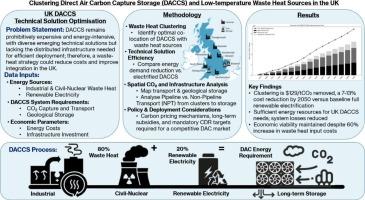聚集直接空气捕获和低温废热资源,以优化英国未来的能源系统
IF 10.9
1区 工程技术
Q1 ENERGY & FUELS
引用次数: 0
摘要
直接空气碳捕获和储存技术从大气中提取二氧化碳,并实现长期封存。作为一种创新的二氧化碳去除方法,直接空气捕获对于实现2015年《巴黎协定》的净零排放至关重要。然而,与其他碳去除方法相比,它是高度能源密集型的,给全球脱碳和能源需求带来了挑战。直接空气捕获系统存在有限的能量系统集成分析,而直接空气捕获系统的能量系统集成分析对于保证系统资源的有效分配至关重要。这种能源密集型技术需要电力、热能和二氧化碳的储存,而这些资源在转化能源系统中的可用性是有限的。在这项研究中,我们分析了未来低碳能源系统中直接空气捕获的能源可用性。我们假设,与全电气化解决方案相比,通过将直接空气碳捕获和储存装置与来自工业和核能的低温废热聚集在一起,可以减少系统损失,最大限度地减少能源需求和运营费用。本研究基于英国的一个案例研究,通过计算可用的低温废热,并应用废热集群的空间资源分析和运输到地质碳储存地点,弥合了废热直接空气碳捕获和储存的开发与实施之间的差距。该研究发现,即使在不太依赖热电厂的能源系统中,也有足够的能源资源来满足直接空气捕获的要求。与参考案例相比,这种方法有助于降低7-13%的成本,即使在废热输入成本增加60%的情况下,也能保持积极的成本优势。本文章由计算机程序翻译,如有差异,请以英文原文为准。

Clustering direct air capture and low-temperature waste heat sources to optimise the United Kingdom’s future energy system
Direct Air Carbon Capture and Storage extracts carbon dioxide from atmospheric air and enables long-term sequestration. As an innovative Carbon Dioxide Removal method, Direct Air Capture is essential to achieving net-zero per the 2015 Paris Agreement. However, it is highly energy-intensive compared to alternative carbon removal methods, posing challenges for global decarbonisation and energy demand. Limited energy system integration analysis exists for Direct Air Capture, which is crucial to ensure efficient resource allocation in an already-constrained system. This energy intensive technology requires power, heat, and carbon dioxide storage, and the availabilities of such resources in the transforming energy system are limited. In this study, we analyse energy availability for Direct Air Capture in a low-carbon future energy system. We hypothesise that by clustering Direct Air Carbon Capture and Storage installations with low-temperature waste heat from industrial and nuclear power sources, system losses are reduced, minimising energy demand and operational expenses versus a fully electrified solution. This research bridges the gap between development and implementation of waste heat Direct Air Carbon Capture and Storage by calculating available low-temperature waste heat and applying spatial resource analysis of waste-heat clusters and transport to geological carbon storage sites, based on a United Kingdom case study. The study finds sufficient energy resources to meet Direct Air Capture requirements, even in an energy system less reliant on thermal plants. This approach facilitates a 7–13% cost reduction versus the reference case, with positive cost advantages maintained even under a 60% increase in waste heat input costs.
求助全文
通过发布文献求助,成功后即可免费获取论文全文。
去求助
来源期刊

Energy Conversion and Management
工程技术-力学
CiteScore
19.00
自引率
11.50%
发文量
1304
审稿时长
17 days
期刊介绍:
The journal Energy Conversion and Management provides a forum for publishing original contributions and comprehensive technical review articles of interdisciplinary and original research on all important energy topics.
The topics considered include energy generation, utilization, conversion, storage, transmission, conservation, management and sustainability. These topics typically involve various types of energy such as mechanical, thermal, nuclear, chemical, electromagnetic, magnetic and electric. These energy types cover all known energy resources, including renewable resources (e.g., solar, bio, hydro, wind, geothermal and ocean energy), fossil fuels and nuclear resources.
 求助内容:
求助内容: 应助结果提醒方式:
应助结果提醒方式:


